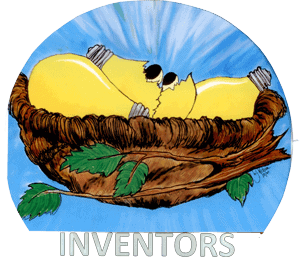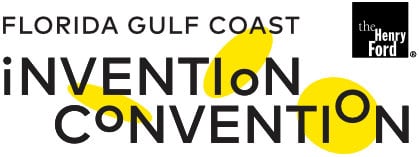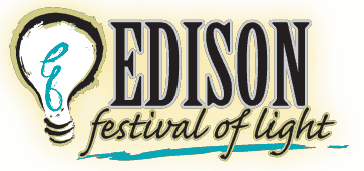
INVENTORS STUDENT RESOURCES



We are living in one of the most challenging and innovative times in history! This is YOUR opportunity to make a difference. Here is a guide to help you succeed with your very own invention.
The Thomas A. Edison Festival of Light Regional Inventors Fair
presented by SONY Electronics
Florida Gulf Coast Hub of the
Henry Ford Invention Convention Worldwide
“If it is to be,
it is up to me!”
Write these 10 two letter words down & post it where you can see it every day!
PROTECTING MY IDEA,
MY INTELLECTUAL PROPERTY
The Henry Ford Invention Convention Worldwide National Program provides this helpful
RUBRIC
Identifying
…a problem is when you brainstorm and use research to discover problems and who might have these problems. You might uncover these problems at home, at your school, with your sports or games, listening to the news or somewhere else entirely.
Understanding
a problem is when you know what is causing the problem and exactly what you want to happen when the problem is solved. The better you understand the problem, the better your solution will be.
Ideating
…means thinking about the problem, brainstorming and researching different ideas and options to solve the problem.
Designing
…is when you decide what your invention solution will be made of, what it will look like and how it will work.
Building
…is when you assemble your invention together based on your solution design using the materials and the process you have decided to use.
Testing
When testing your solution, you will find what works and what doesn’t. You will modify or change your design, then build in those new changes, and test the changes. The testing also includes an analysis of the Pros and Cons of the invention, its impact on society and the environment, its marketability and social value. You keep repeating this process until your invention or prototype works and works well.
Communicating
…is when you explain the problem and your research, how your invention solution solves the problem, who might use your invention, your process in creating this invention, and how you might make it even better.
STEP ONE: INVENTION PROCESS
If you could make a difference, what problems are important to you?
Is there a way to ‘generate’ ideas? YES! Pay attention to . . . .
- . . . unexpected events and how can you make a difference! (Pollution)
- . . . things that go right in nature: Can you mimic it? (Velcro®)
- . . . things that go wrong in nature: Can you help prepare? (Natural disasters)
- . . . something that can help people to obey laws or regulations! (Traffic signs)
- . . . something needed by an age group! (Demographics)
- . . . exploration (Deep sea, space travel and habitation)
- . . . catch a new technology wave and ride it! (see www.su.org )
- . . . mistakes that appear to have benefits (Post It® Notes)
- . . . math that describes a particular process and purpose (BarCode)
Did you know? Everything that is not natural has been created by the human mind! Stop and think about this. Look around you. Every original human made object or unnatural method was invented! This includes the structure you live in, work in, study in; objects you can travel in and over, including space vehicles; food recipes; sports; creative and expressive arts like supplies, instruments, or tools; forms of government and politics; medical equipment and procedures; entertainment; literature; computers, internet, blockchain; algorithms, currencies, energy collection and storage . . . everything that is not naturally occurring!
What Steps Can You Take to Prove ORIGINALITY?
Original means no one has ever made this invention publicly known.
Patent Offices and internet patent data bases provide registered inventions. Not all inventions are registered! Once your idea is made public, you have a limited time to claim it as your personal property.
Important: Review the DISCLAIMER
https://edisonfairs.org/rif/student-resources/#:~:text=Video%20Questions-,Disclaimer,-Search
If you believe your idea is marketable or you have an unnatural occurring method previously unknown and wish to claim it as your ‘intellectual property’ you should consider the benefits and disadvantages of a provisional patent application for temporary 12 month protection and/or a non-provisional patent for up to 20 years of intellectual property protection (IPP).
Learn about these and other forms of IPP (eg. Trademarks, Copyrights).
**** (See www.uspto.gov/kids or www.uspto.gov/teens ) ****
Designing, Building, Testing, & Refining: “Engineering your invention”
RECORD YOUR PROGRESS!
Drawings; material selections; how to build it; test it: record problems; make improvements in function and design. Go for IMPACT!
What makes for a Great Logbook:
- Thorough documentation verified by witnesses
- Required signatures of teacher for approval of idea verifying it is useful, safe, and meaningful, plus proper supervision to be accounted for when working with equipment or materials that could pose a physical hazard. Science Fair Safety Guidelines are in effect for all research associated hazards. (Refer to ISEF guidelines.)
- Parent/Guardian signature(s) on the Permission Form located at the back of the logbook.
- New for 2023:
- A student may use the Edison Fair Logbooks, the HF ICW logbook or any affiliate logbook. (For Española logbooks: see the Connecticut Invention Convention.)
- All grades: clearly distinguish all student entries in logbook from the standard information or questions provided.
- Students in 4th through 12th grades may create their final logbook without including teaching guides or questions.
- Put yourself in a judge’s position. Make your logbook judge friendly!
Arrange by sections that follow the Invention Logbook Criteria as follows: - Identifying & Understanding (recognizing problems)
- Ideating (ideas to solve problems)
- Originality
- Designing, building, testing, and refining
- Value proposition
- Market potential
- Communication planning
- Entrepreneurial planning
- Scientific Research – if this is a co-registered project, your science research can be the last section of the logbook. Be sure to make reference to it in an earlier logbook section.(eg. Originality or Designing)
- 4th – 12th Grades: Required for 2023: Abstract/Summary –a description or summarization of the essential points of the invention.
- Make this the first page of the logbook to serve as an introduction.
- Submit a separate Abstract/Summary as a zFairs Paperwork file.
STEP TWO: INVENTION IMPACT
Describe the beneficial impacts on people (social), the environment, and business (entrepreneurial).
Detrimental impacts: Are there possible concerns for misuse or injury while it is being used that the inventor could be accused of (Liability)? What about pollution?
STEP THREE: INVENTOR COMMUNICATION
Keep legible, detailed records of your all your efforts in your log book . . . including successes AND failures. This is a normal part of getting it right.
NEW 2023 DISPLAY BOARD GUIDELINES
Virtual judging has proven very beneficial and is not limited by travel and narrow time schedules.
In-person events have developed standards much like a tradeshow where physical displays have proven very valuable.
All students will benefit by creating a Digital Display ‘Board’.
This will not add expense to the invention project.
The digital display helps students organize the presentation of their invention ‘story’.
The digital display may be the standardized file in Google Classroom or alternatively, a slide presentation.
Students advancing to the Regional and National Inventors Fairs will be required to have both virtual and physical displays.
Virtual reviewing of invention projects enables identification of projects for special consideration prior to in-person judging.
Physical display boards remain a valued addition to on-site events. Physical displays have been commercially printed using the digital displays.
Physical boards: Standard height is 36 inches but may be as high as 72 inches. All displays must be stable and not subject to falling over.
PROTOTYPE OR MODEL
- Take time to clearly demonstrate or discuss this in detail during your presentation!!!
- If too large, provide a smaller model of your invention. If very small, you can show an enlarged model or illustration.
- Access to Electrical Outlet:
- not an option for live ‘person to person’ judging
- the use of electrical equipment is acceptable for virtual competition
4 to 6 minute VIDEO PRESENTATION
- How to dress for your video? School clothes are recommended at a minimum. Optionally, dress clothes are acceptable.
- The inventor(s) should be the only person(s) speaking. Avoid a Question and Answer Session!
- a physical display and clearly focus in on sections as the discussion progresses. If a judge cannot clearly see what is displayed, think twice about using this approach.
- the aid of a computer or TV screen to present display board information. This is not to replace the inventor’s presence or delivery in the video but to help clarify information and guide the discussion.
- Exception: K-3 grades if necessary to assist the younger participants. If the student is willing, try without assistance even if the video is short (two minutes or less).
- In filming the video, make it judge friendly! The inventor can use:
- The video is to be nonprofessional and unedited for fairness to everyone (national guidelines).
The Next Level (optional): Becoming an Entrepreneur
Participants interested in learning more about selling, licensing, or creating a business based on their intellectual property can benefit by researching the business and professional links noted in the Great Resource List. This list of resources is by no means complete. It contains key resources and will help get you started in your ‘Invention to Entrepreneur’ journey.
Great Resources
(All links verified in August 2022) If you overlook this list you will miss out on many helpful, informative and amazing sites. Video links are especially fun!
SW Florida onsite programs fostering STEM and invention are offered at:
Edison-Ford Estates Youth Camps and IMAG Hands on Exhibits & Makers Lab.
- Henry Ford National Invention Convention – has multiple language Logbook Info. Lesson Plans for Teachers
- Patent searching on USPTO Kids and USPTO Teens
- CA Invention Convention, see Student and Educator links
- The National Inventors Hall of Fame
- For outside the box opportunities, search Disney Imagineering for youth programs, high school and college competitions
- Professionals in the industry (check out LinkedIn for possible people to interview)
- Small Business Administration for the creation and planning of a business
- Small Business Innovation Research for a source of funding
- Service Corps of Retired Executives for free consultations
- Junior Achievement of Southwest Florida: financial literacy, entrepreneurship
- National Association of Manufacturers
- Singularity University
- Lemelson Foundation Invent Teams
- Patent attorneys often provide a free initial consultation; alternatively, you may visit Patent Pathway. Caution: the free information is excellent, but there is a reasonable fee for professional services upon request.
- Inspiration: Imagine Solutions Conference
- Small Business Development Center at FGCU
- National Science Teachers Association
- The Business Model Canvas
Educational & Inspirational STEM Videos
- Boeing FutureU (great for aeronautical interests)
- The Pocket Lab
- Biomimicry (absolutely fascinating)
- Boeing Future U (vast library of experiential videos & future career choices)
- Discovery Education (no need to log in to check this resource out)
- Universe and More (Challenged by physics? Great for gamers!)
- NextGenScience (wish these were available years ago!)
- DreamWorks (Learn how math makes animation flow! Discover what a ‘Shrek’le measurement is.)
Regional Entrepreneurial Degree Programs
- FGCU Daveler & Kauanui School of Entrepreneurship
- FGCU Lutgert College of Business
- FSW School of Business and Technology
- Hodges University
